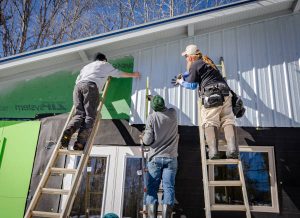Are you searching for an experienced team for all your siding needs in Vancouver? Maintaining the exterior of your home is essential for both aesthetic appeal and structural integrity. Over time, siding can become damaged or worn, necessitating repair or replacement. Repairing or replacing your siding can be challenging, as each option has benefits and considerations. We will explore the factors involved in siding replacement and repair, helping you determine your home’s most appropriate course of action.
Factors involved in siding replacement and repair
1. Assessing the Damage: When to Repair
The first step in determining whether to repair or replace your siding is to assess the extent and type of damage thoroughly. Minor issues such as small cracks, chips, or isolated rot spots can often be addressed through repairs. Repairing damaged siding can be a cost-effective and efficient solution if most siding is still in good condition. For example, only a few boards are affected by moisture damage or insect infestation. In that case, replacing those specific boards and treating the area can restore the integrity of the siding without the need for a full replacement.
When assessing damage, it’s crucial to inspect the entire surface of the siding, paying close attention to areas near the ground, around windows and doors, and at corners. These spots are more prone to damage due to exposure to water and other elements. If the damage is localized and the underlying structure is still sound, repairing the siding can be a practical option. This involves patching holes, filling cracks, or replacing small sections of compromised siding.
Another factor to consider is the age of the siding. Repairs can extend its lifespan without significant investment if your siding is relatively new and in good overall condition. Modern siding materials are designed to be durable and long-lasting, so addressing minor issues promptly can prevent them from escalating into more severe problems. Regular maintenance and timely repairs can help preserve the appearance and functionality of your siding for years to come.
2. Evaluating Extensive Damage: When to Replace
In cases where the damage to your siding is extensive, replacement may be the more viable option. Large-scale issues such as widespread rot, warping, or severe insect damage can compromise the structural integrity of the siding and the underlying framework of your home. If a significant portion of the siding is affected, repairing it may be insufficient to ensure the long-term protection of your home. Additionally, older siding materials may have reached the end of their lifespan and may need to perform more effectively even after repairs.
One key indicator that replacement is necessary is if the siding has become brittle or is cracking extensively. This is particularly common with older vinyl siding exposed to prolonged sunlight and extreme weather conditions. Once siding becomes brittle, it loses its ability to protect your home from moisture and pests, and further repairs may not be effective.
Another scenario where replacement is warranted is when you notice moisture infiltration within your home. Peeling paint, mold growth, or water stains on interior walls can indicate that the siding no longer provides adequate protection against the elements. In such cases, replacing the siding can address the root cause of the problem and prevent further damage to your home’s interior.
Replacing your siding also allows upgrading to newer, more efficient materials. Advances in siding technology have led to the development of materials that offer better insulation, increased durability, and enhanced aesthetic options. For instance, insulated vinyl siding can improve your home’s energy efficiency by reducing heat loss in the winter and keeping your home cooler in the summer. Fiber cement siding offers exceptional durability and resistance to fire, insects, and rot. By choosing to replace your siding, you can enhance your home’s overall performance and appearance.
3. Cost Considerations: Weighing Repair vs. Replacement
Cost is a significant factor when deciding between siding repair and replacement. Repairing damaged siding is generally less expensive than a full replacement, making it an attractive option for homeowners on a budget. The cost of repairs will vary depending on the extent of the damage and the type of siding material. Minor repairs, such as patching holes or replacing a few boards, can be relatively inexpensive and can extend the life of your siding for several more years.
However, it’s important to consider each option’s long-term costs and benefits. While repairs may be cheaper initially, they may not provide a lasting solution if the siding is already nearing the end of its lifespan or if the damage is widespread. Frequent repairs can add up over time and may cost more than a full replacement. Additionally, repairs may not address underlying issues such as poor insulation or structural damage, which could lead to higher energy bills and further maintenance costs in the future.
On the other hand, replacing your siding represents a larger upfront investment but can offer significant long-term savings. New siding can improve your home’s energy efficiency, reduce maintenance costs, and increase value. Upgrading to high-quality materials can also enhance the aesthetic appeal of your home, potentially boosting its curb appeal and resale value. When considering the cost of replacement, it’s important to factor in the potential savings on energy bills and maintenance expenses, as well as the increased value of your home.
Conclusion
Deciding between siding replacement and repair requires careful consideration of several factors, including the extent of the damage, the age and condition of the siding, and the associated costs. By thoroughly assessing the damage and evaluating each option’s long-term benefits and costs, homeowners can make an informed decision that best suits their needs and budget. Repairing minor damage can be a cost-effective solution for relatively new siding in good condition while replacing extensively damaged or aging siding can provide a lasting and efficient solution. Ultimately, the right choice will depend on the specific circumstances of your home and your long-term goals for maintaining and enhancing its exterior. With thoughtful evaluation and planning, you can ensure that your home remains protected, beautiful, and valuable for years.





























